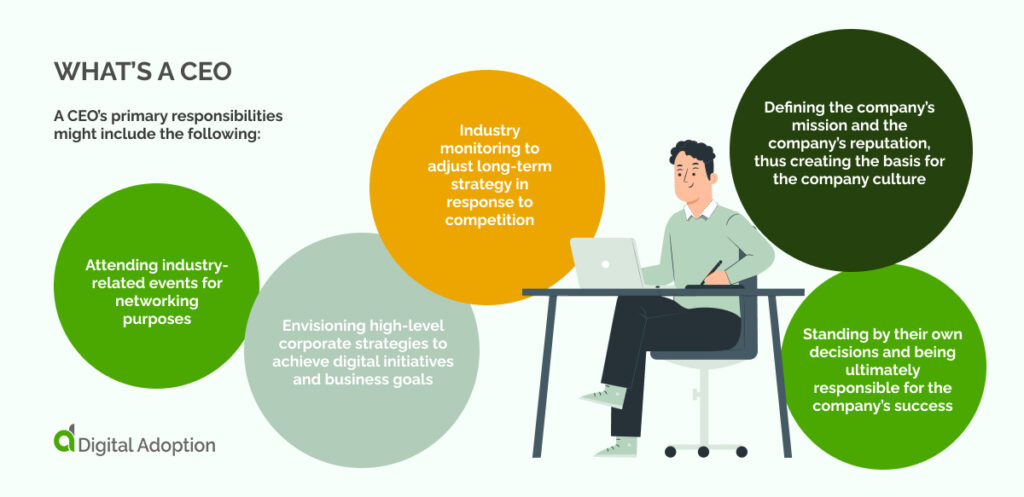In the modern corporate world, businesses often seem to have a never-ending list of acronyms describing their respective organizations’ roles and responsibilities.
In the C-Suite alone, you’ll find:
- Chief Executive Officer
- Chief Operating Officer
- Chief Financial Officer
- Chief Marketing Officer
And several more. Separating the threads and understanding the intricacies of these different roles isn’t always easy. If you want a wider look at C-suite roles, we’ve created a guide. But in this article, we’re tackling a more specific problem.
When it comes to the executive leadership team, two titles that frequently come up for comparison are Chief Operations Officer (COO) and Chief Executive Officer (CEO).
Many business owners and employees may not fully understand the differences, the significance of their respective roles, or how they complement one another in driving an organization forward.
Collaboration between the CEO and COO is critical for successful digital transformation and digital adoption, among many other important business functions.
In this article, we will break down the roles and responsibilities of the COO and CEO and delve into the dynamics that make this partnership a key driver of organizational success.
Defining the Roles of Chief Operating Officer and Chief Executive Officer

First, to understand the differences between the COO and CEO, let’s define their respective roles.
What’s a COO?

A COO is primarily responsible for overseeing a company’s day-to-day operations and internal affairs, ensuring that processes are efficient, and keeping the organization on track to achieve its short-term and long-term goals.
Their responsibilities range from:
- Coordinating financial planning and reviewing financial reports.
- Devising company policies.
- Creating business metrics for financial growth.
- Overseeing all operational functions of a company.
In many cases, the COO is the second in command and serves as a bridge between the CEO and the other senior executives.
What’s a CEO

In contrast, the Chief Executive Officer is the highest-ranking executive in the company, responsible for defining the company’s vision, creating and implementing strategic priorities, and aligning the organization’s resources and efforts toward achieving the established vision and goals.
A CEO’s primary responsibilities might include the following:
- Attending industry-related events for networking purposes.
- Envisioning high-level corporate strategies to achieve digital initiatives and business goals.
- Industry monitoring to adjust long-term strategy in response to competition.
- Defining the company’s mission and the company’s reputation, thus creating the basis for the company culture.
- Standing by their own decisions and being ultimately responsible for the company’s success.
A CEO is also the bridge between the rest of the senior executives and the business owner or board members.
The COO as the ‘How’ and the CEO as the ‘What’

One of the key differences between the two roles is that the COO represents the ‘how’ and the CEO represents the ‘what’ of an organization.
The COO is responsible for establishing the processes and tactics to enable the company to function successfully and achieve its objectives. On the other hand, the CEO develops the company vision, sets the corporate strategy, and is the ultimate decision-maker.
The COO must execute the CEO’s company vision and ensure that the vision is translated into action.
Why the COO Role is Essential to the CEO

The COO-CEO partnership is essential, as it allows the CEO to focus on setting the company’s strategic direction while the COO works on executing internal operations.
A CEO who also shoulders the burden of overseeing daily operations may find themselves stretched too thin, leading to missed opportunities, inadequacies in strategy, or a lack of focus on long-term goals.
Additionally, having a partner who can ensure that the company operates efficiently can free up the CEO’s time for external-facing activities such as networking, investor relations, and public relations.
Collaboration is Key

The key to a successful CEO-COO partnership is collaboration.
As with any partnership, trust and open communication are vital to success. The CEO and COO must actively collaborate and make decisions based on input from one another. The CEO must trust the COO to effectively execute the strategies while the COO must believe in the CEO’s vision for the company.
Leveraging each other’s strengths, expertise, and experience leads to success in driving an organization forward.
No One-Size-Fits-All Approach
It is important to note that no two CEO-COO partnerships are identical. They will differ depending on the organization, industry, and individuals involved.
The specific roles of each individual can vary depending on factors such as the size of the company, the lifecycle stage of the business, the founder’s involvement, or the specific skillset of each executive.
Taking the time to assess and define the specific roles within your organization is a critical step in ensuring the success of the CEO-COO partnership.
A Powerful C-Suite Combo

The COO and CEO are two distinct roles, each with a unique set of responsibilities and authority.
While the CEO is responsible for the overall direction and vision of the company, the COO ensures that efficient business operations are in place to execute that vision.
A successful partnership between the COO and CEO is not just about the division of labor but about collaboration, trust, and open communication. By understanding the dynamics between these two positions, you can create a powerful leadership alliance that propels your organization forward and achieves lasting success.







![18 Examples of AI in Finance [2025]](https://www.digital-adoption.com/wp-content/uploads/2025/06/18-Examples-of-AI-in-Finance-2025-300x146.jpg)
![14 Examples of AI in Manufacturing [2025]](https://www.digital-adoption.com/wp-content/uploads/2025/06/14-Examples-of-AI-in-Manufacturing-2025-300x146.jpg)




